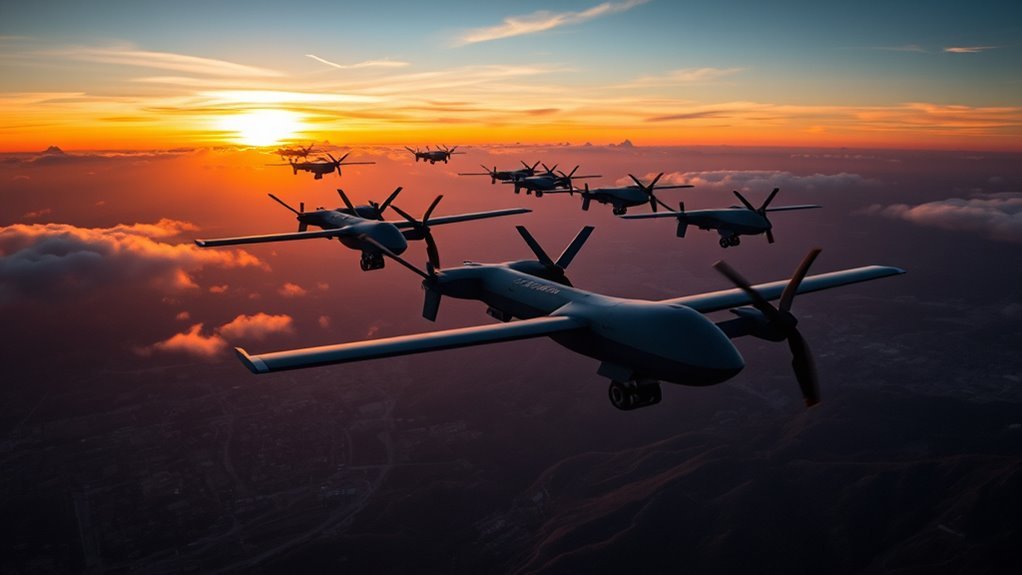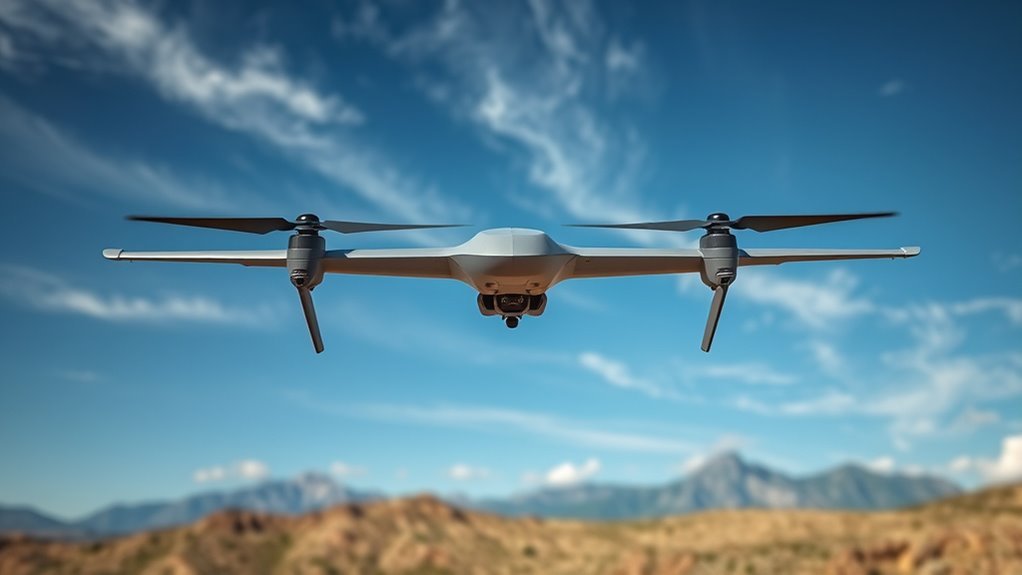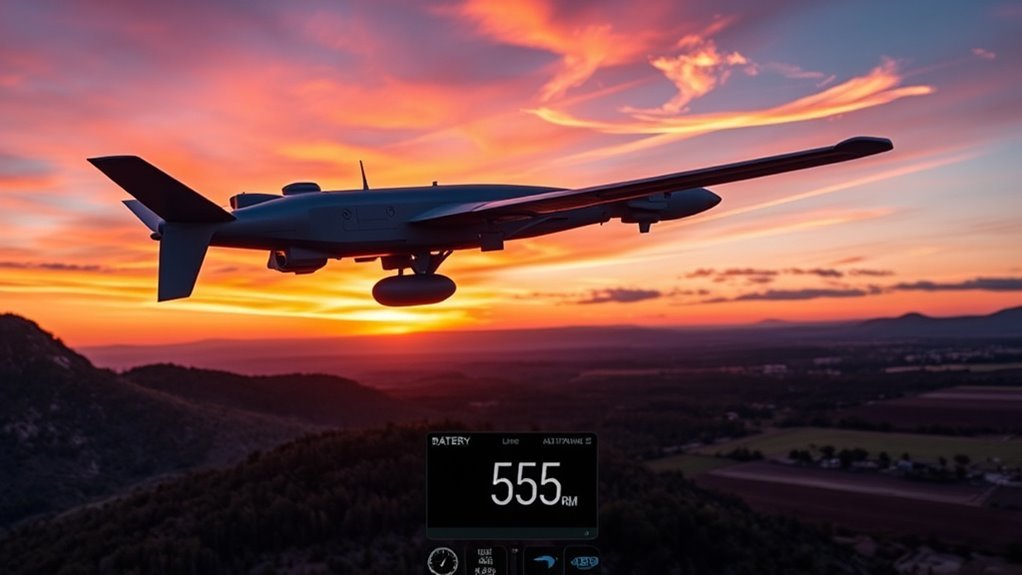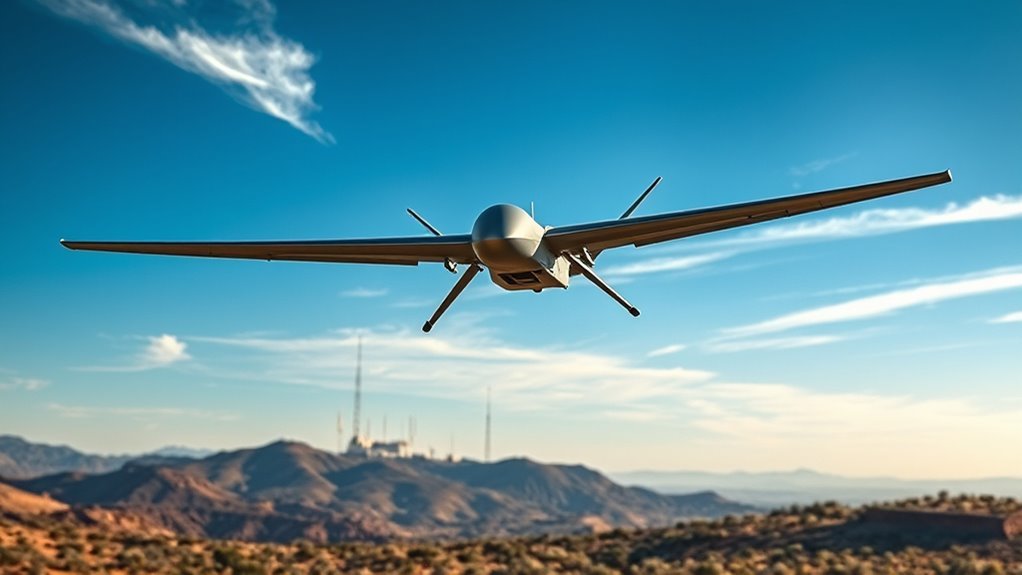Several factors affect how far military drones can fly. The drone’s design and aerodynamic efficiency impact speed and endurance. Payload capacity plays a critical role, as heavier loads reduce flight range. Environmental conditions like wind, altitude, and temperature can influence performance, often increasing energy consumption. Additionally, mission parameters and technological advancements, such as AI and navigation systems, optimize routes and fuel efficiency. Understanding these elements can provide deeper insights into operational range and capabilities.
Drone Design and Specifications

Drone design and specifications play an essential role in determining flight distance, with various factors influencing performance. Aerodynamic efficiency is critical; a streamlined design minimizes drag, allowing you to maximize speed and endurance. When you refine the drone’s shape, it can glide through the air more effortlessly, enhancing overall flight range. Additionally, weight distribution greatly impacts stability and control. By balancing components effectively, you can maintain ideal flight dynamics, preventing unwanted shifts that could compromise distance. A well-balanced drone not only enhances maneuverability but also conserves energy, which is essential for extended missions. Consequently, both aerodynamic efficiency and weight distribution are key considerations in achieving greater flight distances for military drones, enabling you to explore vast operational territories with freedom. Moreover, understanding signal attenuation is vital for optimizing drone performance and ensuring effective communication over long distances. Innovations in advanced AI and autonomy further enhance operational capabilities, allowing military drones to adapt dynamically during missions.
Payload Capacity

Payload capacity considerably influences a military drone’s operational capabilities and flight distance. The weight of the payload directly affects the drone’s efficiency and endurance. When considering payload weight, you should evaluate how different cargo types can impact performance.
Payload capacity is crucial for a military drone’s efficiency, directly affecting its operational capabilities and flight endurance.
- Surveillance Equipment: Lightweight, enhancing flight range.
- Weaponry: Heavier, reducing distance due to increased weight.
- Supplies: Varies in weight, affecting endurance based on cargo type.
Ultimately, a drone’s ability to carry specific payloads must align with its mission objectives. Balancing payload weight against the intended cargo type is crucial for optimizing flight distance, ensuring it meets operational requirements without compromising performance. Choosing the right payload is essential for maximizing the drone’s potential in military operations.
Environmental Conditions

While various factors influence a military drone’s flight distance, environmental conditions play a critical role in determining its operational effectiveness. Weather impact and altitude influence are pivotal in evaluating potential range limitations. Adverse weather, such as high winds or precipitation, can severely hinder a drone’s performance, leading to increased energy consumption and reduced flight distance. Similarly, altitude can affect air density, which in turn impacts lift and propulsion efficiency. Additionally, monitoring weather conditions is essential for ensuring optimal flight performance and safety.
| Factor | Weather Impact | Altitude Influence |
|---|---|---|
| Wind Speed | Increased drag | Thinner air |
| Temperature | Battery efficiency | Reduced lift |
| Humidity | Sensor performance | Engine performance |
Understanding these environmental conditions helps optimize drone missions while ensuring operational success.
Mission Parameters
When taking into account the flight distance of military drones, mission parameters greatly shape operational capabilities. Your mission objectives directly influence the drone’s operational range, determining how far it can effectively travel without compromising its tasks. Factors to bear in mind include:
- Payload Requirements: The weight and type of equipment can affect fuel efficiency and range.
- Flight Duration: Longer missions may require more fuel or battery life, limiting distance. For instance, drones like the Draganfly Vital Intelligence can achieve up to 25 minutes per charge, enhancing their operational range for extended missions.
- Mission Type: Surveillance, reconnaissance, or combat roles demand different operational strategies, impacting range.
Understanding these parameters guarantees that you’re maximizing the drone’s potential while achieving your strategic goals. By carefully defining mission objectives, you can optimize the drone’s performance and extend its operational range effectively. Additionally, advancements in AI-driven autonomy enhance the ability of drones to adapt their flight paths and optimize performance based on real-time mission needs.
Technological Advancements
Mission parameters set the stage for drone operations, but the evolution of technology considerably enhances flight distance capabilities. With advancements in autonomous navigation, drones can efficiently traverse vast territories without constant human oversight. These systems utilize sophisticated algorithms to adapt to changing environments, optimizing flight routes and conserving energy. In addition, cutting-edge communication systems have revolutionized how drones relay data, enabling real-time updates and strategic adjustments during missions. Enhanced bandwidth and secure connections guarantee uninterrupted control over long distances, facilitating complex operations. As these technologies continue to develop, you can expect military drones to cover even greater ranges, empowering armed forces with unprecedented operational flexibility and efficacy, ultimately fighting for your freedom in the skies. Furthermore, the integration of advanced AI and navigation systems allows military drones to perform complex tasks with enhanced precision and efficiency. Moreover, real-time analytics enable faster decision-making, ensuring effective responses during critical missions.
Frequently Asked Questions
How Do Military Drones Compare to Commercial Drones in Flight Distance?
Imagine a military drone like the MQ-9 Reaper, boasting operational ranges exceeding 1,150 miles. In contrast, commercial drones typically have limited drone capabilities, often maxing out around 10 miles, highlighting significant differences in flight distance.
What Is the Average Lifespan of a Military Drone?
The average lifespan of a military drone varies, but typically ranges from five to fifteen years, depending on drone durability and advancements in flight technology. Regular maintenance can further extend operational effectiveness and longevity.
Can Military Drones Be Refueled Mid-Flight?
Yes, military drones can be refueled mid-air using advanced drone technology. This capability considerably extends their operational range and endurance, allowing for prolonged missions without returning to base for fuel replenishment, enhancing tactical flexibility and effectiveness.
What Are Common Maintenance Requirements for Military Drones?
When it comes to military drones, regular inspections and adherence to maintenance schedules are essential. You’ll need to check systems like avionics and propulsion to guarantee peak performance, just like tuning up a classic car.
How Do Regulations Impact Military Drone Flight Distance?
Regulatory constraints impose significant flight limitations on military drones, restricting their operational range. These regulations guarantee safety and compliance, but they can hinder your flexibility and strategic capabilities in deploying drones effectively in various scenarios.

